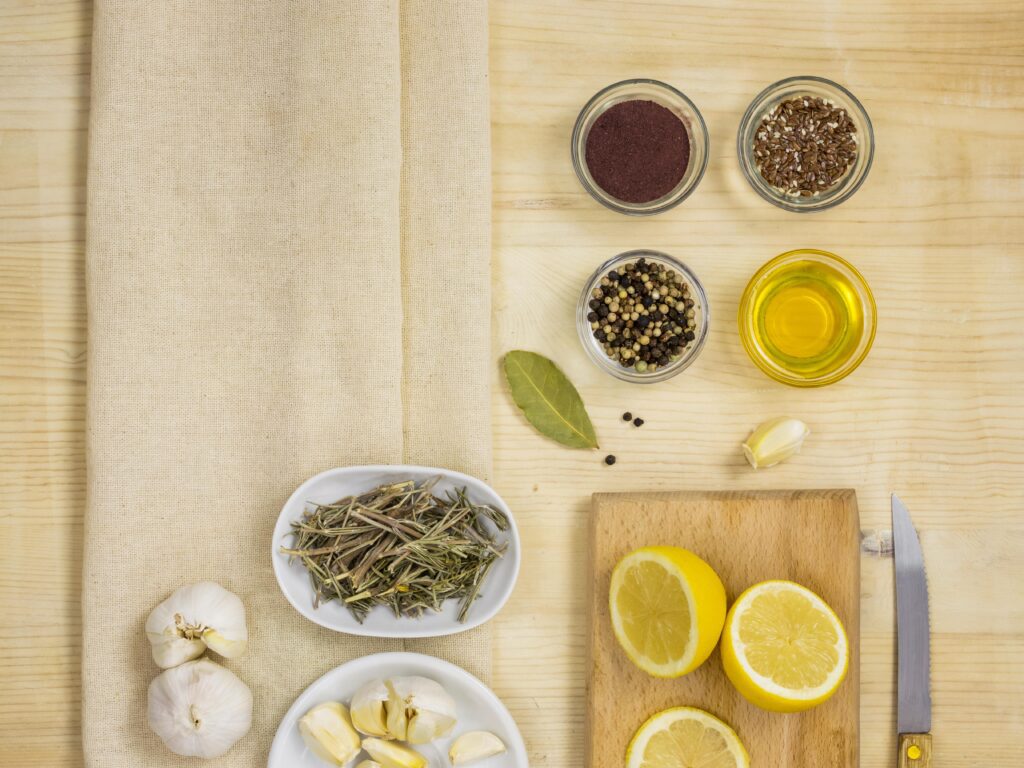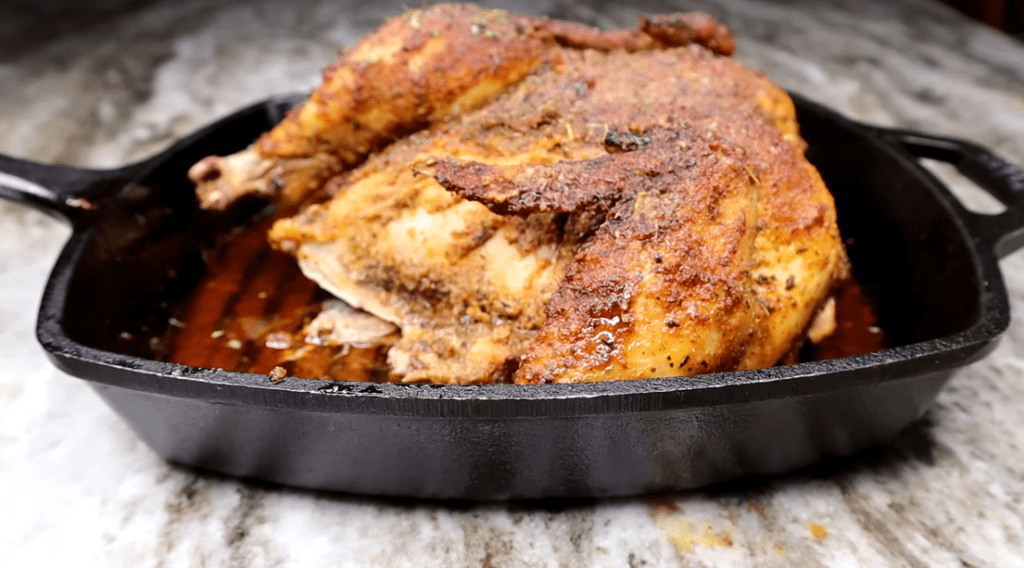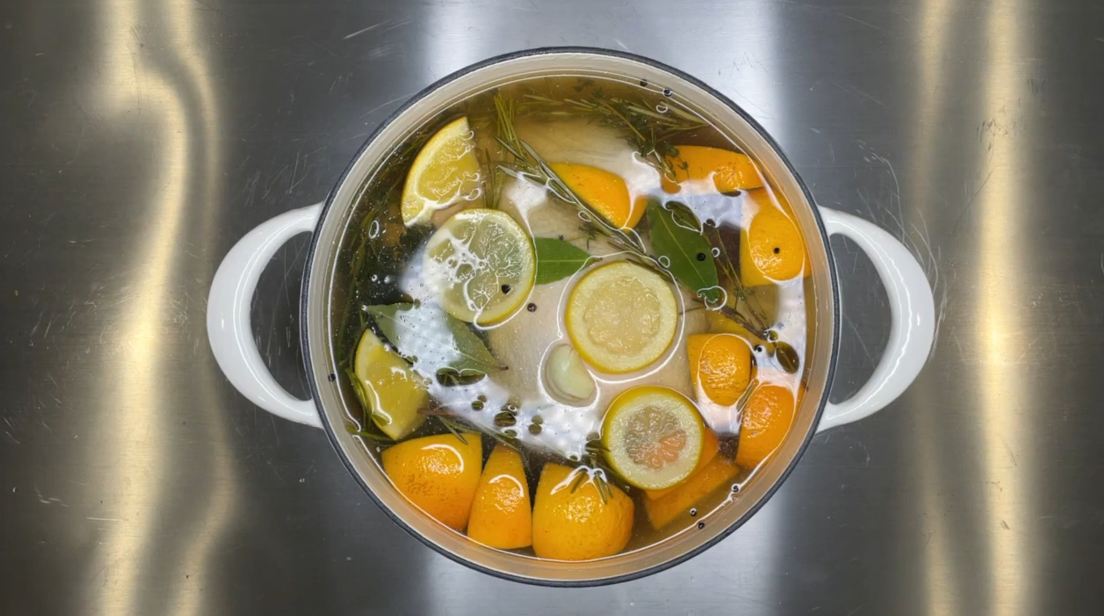Introduction and Basics of Chicken Brine
What is Chicken Brine?
before talking about Chicken Brine Recipe .. Imagine a roast chicken so succulent, so juicy, that each bite feels like a burst of flavor. Now, how do you achieve that? The secret lies in brining, a simple yet transformative process that involves soaking the chicken in a solution of salt and water, often with added herbs and spices. This technique works wonders by infusing the chicken with moisture and seasoning it from the inside out.
When you brine a chicken, you’re not just making it taste better; you’re ensuring that every part of the bird—yes, even the dreaded dry breast—stays juicy. The salt in the brine breaks down the proteins in the meat, allowing it to retain more moisture during cooking. The result? A bird that’s tender, flavorful, and anything but ordinary.
This Chicken Brine Recipe will transform your roast chicken into a juicy, flavorful masterpiece.
Why Brining is Important

So, why should you bother with brining? Well, if you’ve ever roasted a chicken only to find it dry and underwhelming, brining is your saving grace. It’s a game-changer, especially when you’re aiming for that perfect roast chicken with crispy skin and moist meat. Not only does brining chicken lock in moisture, but it also imparts a subtle flavor that elevates the dish to a whole new level.
Additionally, brining is versatile. Whether you’re roasting, grilling, or frying, the process works for various cooking methods, making it a go-to for anyone looking to up their chicken game. Plus, with the right combination of herbs and spices, you can customize the brine to suit your taste preferences—be it a hint of citrus from lemons, the earthy aroma of rosemary, or the sweet note of honey.
Speaking of customization, there’s no need to stick strictly to traditional recipes. The beauty of brining lies in its flexibility. You can experiment with different ingredients to create a brine that’s uniquely yours. For instance, swapping out water for apple cider or adding a splash of bourbon can add a delightful twist to your brine.
But don’t just take my word for it; there’s a wealth of knowledge out there on the science of brining and how it enhances flavor and texture. If you’re curious about the nitty-gritty details, you can check out more in-depth resources like The Science of Brining for a deeper dive into the topic.
In essence, if you’re looking to create the most flavorful and juicy chicken of your life, brining is an absolute must. It’s simple, effective, and once you try it, you’ll wonder how you ever cooked chicken without it.
The Science Behind Brining
Understanding Brine Composition
Let’s dive into the nitty-gritty of brining—why it works and how it transforms your chicken from ordinary to extraordinary. At its core, brining involves two primary ingredients: salt and water. But what’s really happening when you dunk that chicken into the salty bath?
How Salt Works in Brine
Salt is the magic ingredient in any brine. When you submerge chicken in a brine, the salt starts doing its thing, and here’s where the science gets interesting. Through a process called osmosis, the salt in the brine draws out the moisture from the chicken while simultaneously allowing the meat to reabsorb the salty water. This not only seasons the chicken from the inside out but also helps the meat retain more water during cooking.
Moreover, salt breaks down some of the muscle proteins in the meat, particularly the myosin, which leads to a more tender texture. This is why brining chicken not only makes it juicier but also makes the meat more tender—a win-win, really.
Other Essential Ingredients
While salt and water are the non-negotiables, the beauty of brining lies in its versatility. You can enhance the brine with a variety of other ingredients to add depth of flavor. Common additions include:
- Sugar or Honey: These add a touch of sweetness that balances the saltiness, and also helps with browning during roasting.
- Herbs: Fresh herbs like parsley, thyme, and rosemary can impart subtle, aromatic notes that elevate the overall flavor of the chicken.
- Spices: Peppercorns, bay leaves, and garlic are classic choices that add a layer of complexity without overpowering the chicken’s natural taste.
Optional Additives
Want to take your chicken brine recipe to the next level? Experiment with some optional additives:
- Citrus: Adding lemon or orange slices can give your chicken a fresh, zesty flavor.
- Alcohol: A splash of wine, bourbon, or even apple cider can introduce a new dimension of flavor.
- Aromatics: Smashed garlic cloves, sliced onions, or even ginger can work wonders for infusing your chicken with a more complex flavor profile.
Each of these ingredients not only contributes flavor but also plays a role in the overall chemistry of the brine. For instance, sugar helps the chicken develop a beautiful caramelized skin when roasted, while herbs and spices work subtly to enhance the meat’s natural flavors.
Why You Shouldn’t Skip the Extras
Now, you might be tempted to skip some of these optional ingredients, especially if you’re in a hurry. But remember, while salt and water will do the job, these extras are what can make your chicken truly memorable. They add that little something that makes people say, “Wow, what did you do to this chicken?”
Plus, the flexibility of brining means you can adjust the recipe to suit your taste or even the occasion. Whether you’re aiming for a simple weeknight dinner or a show-stopping holiday roast, tailoring your brine to your needs is easy.
For more details on how different ingredients affect the brining process, you can explore guides like How to Brine Chicken for the Best Flavor, which dives deeper into ingredient choices and their impacts.
In summary, understanding the science behind brining not only helps you achieve the best results but also empowers you to experiment with different flavors and techniques. So go ahead, mix things up, and enjoy the delicious rewards!
Step-by-Step Guide to Making Chicken Brine
Choosing the Right Ingredients

Before you start making your brine, let’s talk about the ingredients you’ll need. The foundation of any good brine is, of course, salt and water. But, as we’ve touched on earlier, the real magic happens when you start adding other elements like herbs, spices, and sweeteners. Understanding the science behind this Chicken Brine Recipe is key to achieving perfect results.
Selecting Salt Types: Kosher vs. Table Salt
Not all salts are created equal when it comes to brining. The type of salt you use can significantly affect the outcome of your brine. Kosher salt is the go-to choice for most brine recipes because it dissolves quickly and has a pure, clean flavor. Its larger grains also make it easier to control the salinity of your brine.
On the other hand, table salt has smaller grains, which can lead to a saltier brine if you’re not careful. If you’re using table salt, you’ll need to reduce the amount slightly to avoid over-salting your chicken.
Flavor Boosters: Herbs, Spices, and Sweeteners
Once you’ve got your salt sorted, it’s time to think about what else you want to add to the brine. Here are some popular options:
- Herbs: Fresh herbs like rosemary, thyme, and parsley can add a subtle, aromatic flavor to your chicken. You can also use dried herbs, but fresh is always better if you can get it.
- Spices: Whole spices like peppercorns, bay leaves, and garlic cloves are classic additions that can deepen the flavor of your brine.
- Sweeteners: Adding a touch of honey, brown sugar, or even maple syrup can help balance the saltiness and add a slight caramelization to the skin when roasting.
Preparation of the Brine
Now that you’ve gathered your ingredients, it’s time to put them together. The process is straightforward, but there are a few tips that can make a big difference in the final product.
Step-by-Step Instructions
- Heat a Portion of Water: Start by heating about a third of the total water you’ll need in a large pot. This will help dissolve the salt and extract flavors from the herbs and spices.
- Dissolve the Salt: Add the salt to the hot water and stir until fully dissolved. If you’re using sweeteners like honey or sugar, add them now as well.
- Add Herbs and Spices: Toss in your choice of herbs, spices, and any other flavorings you’re using. Allow the mixture to simmer for a few minutes to release the flavors.
- Cool the Brine: Once the salt is dissolved and the flavors have melded, remove the pot from the heat. Add the remaining cold water to bring down the temperature. It’s crucial that the brine is completely cool before you add the chicken; otherwise, you risk partially cooking the bird or creating an unsafe environment for bacteria to grow.
- Submerge the Chicken: Place the chicken in a large container or pot, breast side down, and pour the cooled brine over it. Make sure the chicken is fully submerged.
- Refrigerate: Cover the container and refrigerate the chicken for 12 to 24 hours. The longer it brines, the more flavorful and moist it will be. However, don’t exceed 24 hours as the meat can become too salty and start to break down.
Important Tips for Best Results
- Use a non-reactive container: Glass, stainless steel, or plastic are best for holding the brine. Avoid using aluminum or copper as they can react with the salt and other ingredients, affecting the flavor.
- Keep it cold: The brine must stay cold the entire time the chicken is submerged. If your refrigerator is crowded, consider placing the container in an ice-filled cooler.
- Pat dry before cooking: Once you’re ready to cook, remove the chicken from the brine, rinse it under cold water to remove excess salt, and pat it dry thoroughly. This step is crucial for getting that coveted crispy skin when roasting.
How Long to Brine Chicken
Timing is everything in brining. For most chickens, a brining time of 12 to 24 hours is ideal. The exact time depends on the size of the chicken and your taste preferences.
- 12 hours: This is the minimum time to achieve noticeable results. The chicken will be juicier and more flavorful, but the seasoning won’t be as deep.
- 18 to 24 hours: This is the sweet spot for most people. The chicken will be fully seasoned, with maximum moisture retention and a slight but noticeable flavor from the herbs and spices.
If you’re in a pinch and can’t brine for a full 12 hours, even a few hours can make a difference. However, avoid brining for longer than 24 hours as it can lead to overly salty meat.
In summary, the right ingredients and proper technique are key to making a great chicken brine recipe. With these steps, you’ll be on your way to preparing the juiciest, most flavorful chicken you’ve ever tasted.
Follow this Chicken Brine Recipe step by step to ensure your chicken is perfectly seasoned
Roasting Brined Chicken to Perfection

Preparing the Chicken for Roasting
So, you’ve brined your chicken, and now it’s time to bring it all together with a perfect roast. But before you pop that bird in the oven, a little preparation goes a long way in ensuring your chicken is as delicious as possible.
Drying and Seasoning the Brined Chicken
After the brining process, it’s crucial to rinse the chicken under cold water to remove any excess salt that might linger on the surface. This step is essential because while the brine has done its job of infusing the meat with flavor and moisture, you don’t want the exterior to be too salty.
Once rinsed, pat the chicken dry with paper towels. And when I say dry, I mean really dry! Any moisture left on the skin will prevent it from crisping up properly in the oven, and let’s be honest—crispy skin is one of the best parts of a roast chicken.
Now, even though the chicken is already seasoned internally from the brine, you’ll still want to add a little extra flavor to the exterior. A light brushing of melted butter not only enhances the taste but also helps with browning. Sprinkle just a touch of salt and pepper on the skin to finish. Remember, less is more here since the chicken is already seasoned inside.
Setting Up the Roasting Pan
The setup is simple but effective. Place your chicken on a rack inside a roasting pan, breast side up. The rack elevates the chicken, allowing hot air to circulate around it, which is key for even cooking and achieving that golden, crispy skin.
If you don’t have a roasting rack, you can improvise by placing a few thick slices of onion, carrot, or even halved potatoes under the chicken. This not only serves the same purpose as the rack but also adds a bit of flavor to the drippings, which you can use later to make gravy.
Roasting Techniques
Alright, your chicken is prepped and ready, but how do you make sure it roasts to perfection? The secret lies in the temperature and time.
Temperature and Time Guidelines
Preheat your oven to a high temperature, around 430°F (220°C). This initial blast of heat helps to render the fat in the skin quickly, promoting crispiness. After about 15 minutes, reduce the oven temperature to 350°F (180°C) and continue roasting until the chicken is done.
A general rule of thumb is to roast the chicken for about 15 minutes per pound, but always rely on an internal temperature check for accuracy. The chicken is done when the thickest part of the thigh reaches 165°F (75°C). Use a meat thermometer to check—this is non-negotiable if you want to avoid undercooking or overcooking your bird.
One more thing: halfway through roasting, it’s a good idea to rotate the pan to ensure even browning. If you notice that the skin isn’t browning evenly, you can also brush the top with a little more melted butter or oil.
Tips for Achieving Crispy Skin and Juicy Meat
Crispy skin and juicy meat might sound like a contradiction, but with a brined chicken, it’s entirely achievable. Here are a few tips:
- Don’t rush the drying: As mentioned earlier, make sure the chicken is thoroughly dried before roasting.
- Let the chicken rest: After you take the chicken out of the oven, resist the urge to cut into it right away. Let it rest for 10-15 minutes, loosely covered with foil. This allows the juices to redistribute throughout the meat, ensuring every bite is moist.
- Use high heat strategically: Starting with a high oven temperature and then lowering it helps achieve that perfect balance of crispy skin and tender meat.
- After using this Chicken Brine Recipe, you’ll notice how the flavors penetrate deeply into the meat, making every bite deliciously seasoned.
Common Mistakes to Avoid
Even seasoned cooks can make mistakes when roasting a brined chicken, but being aware of potential pitfalls can save your meal.
- Over-brining: Leaving the chicken in the brine for too long can result in overly salty meat. Stick to the recommended brining times.
- Skipping the rinse: Not rinsing off the brine before roasting can make the chicken too salty on the outside.
- Not using a meat thermometer: Guessing the chicken’s doneness by cooking time alone can lead to undercooked or overcooked meat. Always check the internal temperature
In conclusion, roasting a brined chicken is all about balance—balancing moisture and crispiness, seasoning and simplicity. Follow these steps, and you’ll end up with a roast chicken that’s not only packed with flavor but also boasts perfectly crispy skin and juicy meat. After completing this Chicken Brine Recipe, your chicken will roast to perfection.
Variations of Chicken Brine Recipes
Simple Brine Recipe
Sometimes, simplicity is key. If you’re new to brining or just want a straightforward approach, a basic brine with just salt and water will still work wonders. This minimalist method is all about letting the natural flavors of the chicken shine through, with the salt doing most of the heavy lifting.
Ingredients:
- 2 quarts cold water
- 1/3 cup kosher salt
Instructions:
- Dissolve the Salt: In a large pot, dissolve the kosher salt in hot water. Stir until completely dissolved.
- Cool the Brine: Add the remaining cold water to bring the temperature down. Ensure the brine is completely cool before using.
- Brine the Chicken: Submerge your chicken in the brine, refrigerate, and let it sit for 12 to 24 hours.
This simple brine recipe is perfect for those who prefer a pure chicken flavor without any additional herbs or spices. It’s also a great base to start from if you want to experiment with other flavors later.
Herb-Infused Brine
For those who love a bit of herbal aroma in their roast chicken, an herb-infused brine is a delightful choice. The herbs not only add flavor but also make the kitchen smell amazing while the chicken is roasting.
Ingredients:
- 2 quarts cold water
- 1/3 cup kosher salt
- 10 sprigs of fresh thyme
- 5 sprigs of rosemary
- 5 bay leaves
- 10 sprigs of parsley
Instructions:
- Boil and Infuse: Heat half of the water and dissolve the salt. Add the fresh herbs and let the mixture simmer for a few minutes to release the flavors.
- Cool and Combine: Remove from heat and add the remaining cold water. Allow the brine to cool completely before submerging the chicken.
- Brine the Chicken: Submerge the chicken in the herb-infused brine and refrigerate for 12 to 24 hours.
The herbs in this brine add a subtle, earthy flavor that complements the chicken perfectly. Plus, the aroma during roasting will make your mouth water long before the chicken is done.
Citrus Brine
If you’re looking to add a bright, zesty flavor to your chicken, a citrus brine is the way to go. The acidity from the citrus fruits helps tenderize the meat while imparting a fresh, vibrant taste.
Ingredients:
- 2 quarts cold water
- 1/3 cup kosher salt
- 2 lemons, quartered
- 1 orange, quartered
- 5 bay leaves
- 10 peppercorns
Instructions:
- Dissolve Salt and Add Citrus: Heat half of the water, dissolve the salt, and add the citrus fruits, bay leaves, and peppercorns. Simmer for a few minutes to combine the flavors.
- Cool the Brine: Add the remaining cold water to the mixture and let it cool completely.
- Brine the Chicken: Submerge the chicken in the citrus brine and refrigerate for 12 to 24 hours.
This brine is perfect for those who enjoy a hint of citrus in their chicken. The lemon and orange flavors add a refreshing twist that pairs beautifully with the natural richness of the roasted meat.
Sweet and Savory Brine
For a brine that balances both sweet and savory notes, try adding a touch of honey or brown sugar. This sweet and savory brine is particularly great for roasting, as it helps the chicken develop a beautiful caramelized skin.
Ingredients:
- 2 quarts cold water
- 1/3 cup kosher salt
- 1/4 cup honey (or brown sugar)
- 5 garlic cloves, smashed
- 5 sprigs of thyme
Instructions:
- Combine and Heat: Heat half of the water, dissolve the salt, and stir in the honey or brown sugar until fully dissolved. Add the garlic and thyme and let it simmer for a few minutes.
- Cool and Brine: Add the remaining cold water to cool the brine, then submerge the chicken in the mixture.
- Refrigerate: Let the chicken sit in the sweet and savory brine for 12 to 24 hours in the refrigerator.
The honey or brown sugar in this brine adds a slight sweetness that balances the saltiness, creating a rich and flavorful roast chicken with a hint of caramelization on the skin. Experiment with different variations of this Chicken Brine Recipe to find your favorite flavor combination.
Serving Suggestions and Pairings
Side Dishes to Complement Brined Chicken
Once you’ve perfected your brined chicken recipe, it’s time to think about what to serve alongside it. The right side dishes can elevate your meal, adding balance and enhancing the flavors of the juicy, seasoned chicken. Here are some tried-and-true pairings that work beautifully with brined chicken.
Potato Sides: Mashed, Roasted, or Gratin
Potatoes and chicken are a classic combination, offering comfort and satisfaction with every bite. Whether you prefer them mashed, roasted, or layered in a creamy gratin, potatoes complement the rich, savory flavors of the chicken perfectly.
- Mashed Potatoes: Creamy, buttery mashed potatoes are a fantastic choice. They’re simple to make and provide a smooth, comforting texture that contrasts nicely with the crispiness of the roasted chicken skin.
- Roasted Potatoes: For those who love a bit of crunch, roasted potatoes seasoned with herbs and garlic are ideal. They soak up the pan juices from the chicken, making them irresistibly flavorful.
- Potatoes au Gratin: If you’re looking to impress, a rich and creamy potatoes au gratin dish is a showstopper. The layers of thinly sliced potatoes baked in cream and cheese create a decadent side that pairs wonderfully with the juicy chicken.
Vegetable Sides: Green Beans, Salads, etc.
To add freshness and color to your plate, consider pairing your brined chicken with some crisp, green vegetables. Not only do they provide a nutritional boost, but they also offer a light, refreshing contrast to the rich flavors of the chicken.
- Green Beans with Almonds: Lightly steamed green beans tossed with toasted almonds and a squeeze of lemon make for a vibrant and crunchy side dish.
- Crisp Garden Salad: A simple salad with mixed greens, cherry tomatoes, cucumbers, and a tangy vinaigrette is always a welcome addition. It’s light and refreshing, balancing the richness of the chicken.
- Roasted Brussels Sprouts: For a heartier vegetable side, try roasting Brussels sprouts with a drizzle of balsamic glaze. The slightly caramelized, crispy edges add depth and texture to the meal.
Bread Options: Rolls, Biscuits, or Soda Bread
No chicken dinner is complete without some form of bread on the table. Whether you prefer soft rolls, flaky biscuits, or a rustic soda bread, these options are perfect for mopping up the delicious pan juices or gravy.
- No-Knead Dinner Rolls: Soft, fluffy dinner rolls are a classic choice. They’re perfect for soaking up the rich juices from the chicken and make a comforting addition to the meal.
- Buttermilk Biscuits: Light and flaky buttermilk biscuits bring a Southern charm to the table. Their buttery goodness pairs well with the savory flavors of the brined chicken.
- Irish Soda Bread: For a rustic, hearty option, try serving a slice of crusty Irish soda bread. Its dense texture and slight tang from the buttermilk make it an excellent companion to the juicy chicken.
Beverage Pairings
The right beverage can elevate your meal, complementing the flavors of the chicken and sides. Whether you prefer wine, beer, or a non-alcoholic option, here are some pairings that work well with brined chicken.
- White Wine: A crisp, dry white wine like Sauvignon Blanc or Chardonnay pairs beautifully with brined chicken. The acidity in the wine cuts through the richness of the chicken, creating a balanced flavor experience.
- Light Beer: If you’re a beer lover, a light, refreshing beer like a Pilsner or Lager is a great choice. It’s not too heavy, allowing the flavors of the chicken to shine.
- Sparkling Water with Citrus: For a non-alcoholic option, try sparkling water with a twist of lemon or lime. It’s refreshing and helps cleanse the palate between bites.
Pairing sides with this Chicken Brine Recipe enhances the overall dining experience, ensuring that every component complements the juicy, flavorful chicken
FAQs on Chicken Brine Recipe
Brining might seem straightforward, but it often raises a few questions, especially for those new to the process. Here are some frequently asked questions that can help clear up any uncertainties and ensure your chicken brine recipe turns out perfectly.
Is Brining Necessary for Chicken?
While brining isn’t absolutely necessary, it’s highly recommended if you want to achieve the juiciest and most flavorful chicken possible. Brining enhances the chicken’s moisture content and seasons the meat all the way through, resulting in a more tender and flavorful dish. Without brining, chicken can easily dry out during cooking, especially when roasting.
How Long Can You Brine Chicken?
The ideal brining time is typically between 12 to 24 hours. This duration allows the salt to penetrate the meat thoroughly, ensuring even seasoning and moisture retention. However, you should avoid brining for longer than 24 hours, as the chicken can become overly salty and start to take on a rubbery texture. If you’re short on time, even a few hours of brining can improve the flavor and texture, though the results won’t be as pronounced.
Can You Use This Brine for Other Meats?
Absolutely! The principles of brining apply to many types of meat, not just chicken. Turkey, pork, and even certain cuts of beef can benefit from brining. The key is to adjust the brining time based on the size and type of meat. For instance, turkey often requires a longer brining time due to its larger size, while pork chops might only need a few hours. A great resource to learn more about brining other meats can be found in guides like Brining 101: Everything You Need to Know.
What’s the Difference Between Brining and Marinating?
Brining and marinating might seem similar, but they serve different purposes. Brining primarily focuses on moisture retention and seasoning by using a higher ratio of liquid (typically water) to meat, with salt being the key ingredient. On the other hand, marinating often involves a more concentrated mixture of oil, acid (like vinegar or lemon juice), and spices that primarily coat the surface of the meat, adding flavor and sometimes tenderizing it depending on the acidity of the marinade.
What’s the Best Salt to Use for Brining?
Kosher salt is the best option for brining. Its coarse grains dissolve easily and distribute evenly in the water, making it ideal for this purpose. Table salt, with its finer grains, can lead to over-salting if used in the same quantity as kosher salt, so it’s important to adjust the amount if you’re using table salt. As a general rule, use less table salt than kosher salt to achieve the same level of salinity.
Conclusion and Final Tips
Summary of Key Points
Brining is a simple yet transformative technique that can take your chicken from average to extraordinary. By soaking the chicken in a solution of salt, water, and optional flavorings like herbs, spices, and citrus, you infuse the meat with moisture and seasoning. This process results in a roast chicken that is juicy, tender, and bursting with flavor—right down to the bone.
We’ve covered various aspects of brining, from the basic science behind how it works to step-by-step instructions on making different types of brine. Whether you prefer a straightforward salt-water brine, a zesty citrus infusion, or a sweet and savory blend, there’s a brine recipe that will suit your taste.
Final Tips for Perfect Brined Chicken
Before you start your next brining adventure, here are a few final tips to ensure your chicken turns out perfectly every time:
- Timing is Everything: Stick to the recommended brining time—typically 12 to 24 hours for chicken. Brining too long can result in overly salty or rubbery meat, while not brining long enough may not deliver the full benefits.
- Keep it Cool: Always brine your chicken in the refrigerator or a well-chilled environment. This not only keeps the chicken safe from bacteria but also helps the meat absorb the brine evenly.
- Rinse and Dry: Don’t forget to rinse your chicken thoroughly after brining to remove excess salt from the surface. Patting the chicken dry is equally important for achieving that desirable crispy skin during roasting.
- Use a Meat Thermometer: To avoid undercooking or overcooking, use a meat thermometer to check the internal temperature of the chicken. Aim for 165°F (75°C) at the thickest part of the thigh.
Encouragement to Experiment with Different Flavors
One of the joys of brining is its flexibility. Don’t be afraid to experiment with different ingredients and flavor combinations. Perhaps you’ll find that adding a splash of bourbon to your brine gives the chicken a delightful twist, or maybe you’ll discover that fresh herbs from your garden bring out the best in your roast. The possibilities are endless, and each experiment brings you closer to finding your perfect brine.
For further exploration of flavor and brining techniques, resources like How to Brine Chicken for the Best Flavor offer additional insights that can help you refine your brining skills. With this Chicken Brine Recipe, you’ll enjoy the most tender and flavorful chicken you’ve ever made
In conclusion, brining is more than just a step in the cooking process—it’s a surefire way to elevate your chicken dishes to new heights. So go ahead, give brining a try, and enjoy the delicious, juicy results!
Don’t miss out on trying this Chicken Brine Recipe—it’s the key to transforming ordinary chicken into an unforgettable meal.

